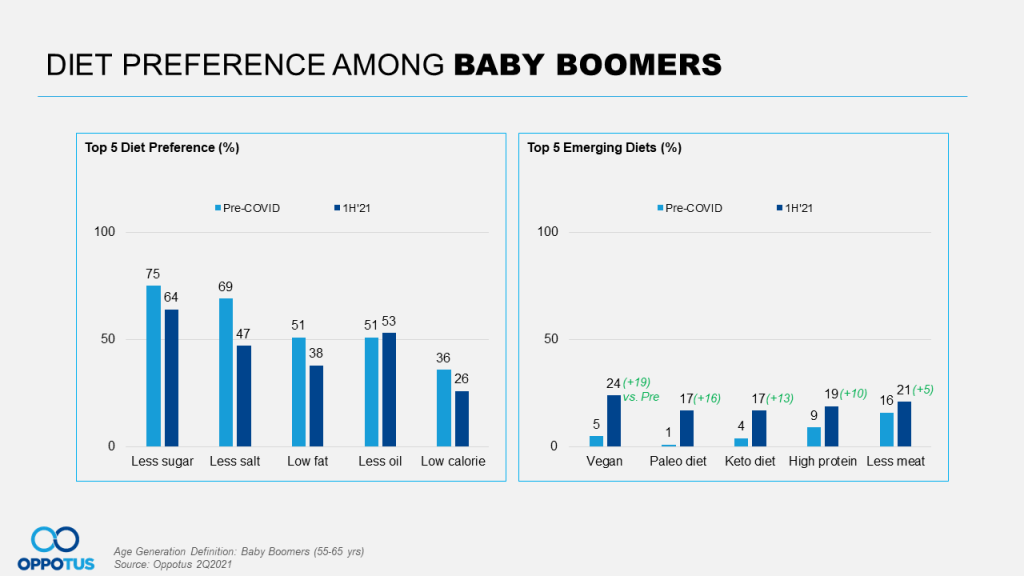Food has always been a vital part of the Malaysian identity. We pride ourselves on our wide variety of national dishes which are rightfully consumed as a large portion of the population’s regular diet. Malaysians are known to be more than happy to indulge in our local delights, to the point that our population is recognised to be the most overweight out of all the countries in Southeast Asia, with 50.1% of our population reported to be either overweight or obese. However, this won’t necessarily be the case going into the future. The COVID-19 pandemic has caused a drastic change in the lifestyles of Malaysians since early 2020, and naturally this also meant a big change for Malaysian diets thanks to the myriad of restrictions that were imposed on restaurants. From casual meals at coffee shops to dining at high-end restaurants, eating out is something that the vast majority of Malaysians do, whether it’s for leisure or out of necessity due to their lifestyles which require them to be out on most days. With dining-in being restricted and many Malaysians being forced to work from home over the course of the pandemic, how have Malaysian diets adjusted?
What do we Mean by Diets?
What comes to mind when people see the word “diet”? Many would automatically assume that a diet is some form of weight management or restriction of food. Thus, some people may shy away from the word as they think it’s a word that implies that they are unhappy with their current weight. However, diet actually refers to the food that we usually eat on a daily basis. As such, diet doesn’t necessarily refer to any sort of weight loss regime but merely a preference in food or eating habits.
Despite that there are certain diet plans or diet trends that promote balanced nutrition to maintain a healthy lifestyle. For business leaders in the food and beverage industry, the food and drinks they offer isn’t just about satisfying hunger or catering to people’s taste buds. Consumers are always changing their shopping habits especially when a change in their daily life occurs such as increased prices, consumer perception on health issues, and the more recent movement restrictions due to COVID-19. These cause consumers to adopt new habits, diets and the way they choose their groceries. Understanding the latest consumer trends will help businesses stay relevant and give them an advantage in the market.
What Types of Diets are There?
There are many types of diets, each with their own pros and cons. Just as there is no one best solution for any situation, there is no one best diet. Different types of diets exist for different types of bodies. The diet of a white collar worker is vastly different from the diet of a blue collar worker as they exert different strengths in their work life.
One of the most commonly known diets is the vegan diet. Veganism is a strict form of a vegetarian for ethical, environmental, or health reasons. Besides avoiding meat they also do not allow dairy, eggs, or animal-derived products such as honey and gelatine.
The Paleo Diet has recently gained popularity as an effective weight loss and healthy diet. It is also known as the “Caveman Diet” since the idea of this diet is to eat what our hunter-gatherer ancestors ate. The main theory behind the paleo diet is that modern food systems use processing and production that cause damage to human health. Food such as lean meat and fish, eggs, nuts and seeds, fruits, and vegetables are encouraged while food such as processed food, sugar, grains, and dairy are discouraged.
The Keto Diet is a diet that promotes ketosis which is a metabolic state that uses calories from fat instead of carbs to produce energy. The keto diet macronutrient breakdown encourages 65-90% fat, 10-30% protein, and less than 5% carbohydrates. By controlling the macronutrient distribution, they will be able to shift the body’s dependence from carbs to fat.
Do Malaysians Have Diet Preferences?
Generally, Malaysian diets are tuned towards a certain preference, with 79% of Malaysians stating that they do have a diet preference. Our previous report on food trends also highlighted how most Malaysians do have diet preferences, with many Malaysian diets favouring simple and healthy diet plans such as consuming food with less salt, less sugar, and low fat.
With Malaysians becoming more health conscious and opting to cook their own meals more frequently due to the occurrence of COVID-19 and implementation of Movement Control Order (MCO) by the Malaysian Government, 83% of Malaysians have some form of preference when it comes to the food they eat which is a slight increase as compared to before COVID-19 (79%).
Looking in the generation demographics, food preferences have increased among the Millennials and Gen X, while Baby Boomers maintained at 98% before Covid-19 and 96% in the first half of 2021. Gen Z on the other is now less particular about their food intake, dropping from 76% to 62%. In general, the older generations such as Gen X and Baby Boomers are more likely to have preference towards their diets. This comes as no surprise as the older generation are more concerned about their health and some of them may have long term ailments such as diabetes which require special diets.
When it comes to marital status, married individuals (94% in 1H’21) tend to watch their diets compared to single individuals (63% in 1H’21). Generally before COVID-19, 85% of married individuals have food preferences as they want to provide healthy diets for their family or children. The percentage increased to 94% in the first half of 2021 likely due to the implementation of MCO 2.0 which made family members have their meals together more often.
Are Diet Preferences the Same Pre-COVID vs 1H’21?
According to the graph, less salt, less sugar, low fat, less oil, and low calorie are among the time 5 most preferred options for Malaysian diets regardless of the time frame be it before COVID-19 or in the first half of 2021. Now, less sugar has increased from 45% to 48% and less oil noticeably rose from 35% to 43%, taking the top spot in the 1H’21 list. Preference for less salt has decreased from 46% to 35% in 1H’21. Possibly it has become more of a hygiene factor when it comes to food intake.
On top of that, adoption for low carbohydrate, high protein, vegan, keto diet and paleo diet are all on the rise since the occurrence of COVID-19. The keto diet was especially popularised in 2020 to 2021 due to a variation in the diet known as “Keto Lite” that changed the diet distribution to high protein (as compared to the 10-30% of a traditional keto diet), moderate fat, and low sugar.
What are the Diet Preferences Among Millennials?
Delving deeper into the demographics of Malaysian diets, we took a look at the Millennial generation and found that females care more about their food intake, with 85% of them now have some form of diet preference as compared to pre-COVID at 71%. This is likely due to the implementation of MCO restricting people from going out for recreation or exercise. Generally females are more concerned about their figures, as it may be difficult to exercise at home without equipment they opted for other ways to maintain their figure which is to change their diets.
The top 5 key diets among Millennials remained the same in 1H’21. The uplift is seen across all diets with the exception of less salt which decreased from 41% to 31%. Apart from those key diet preferences, they tend to also go for low carb and high protein diets while also adopting special diets such as detox, organic, and keto diets.
What are the Diet Preferences Among Baby Boomers?

Looking into Baby Boomers, the intensity for preference in less sugar, less salt, low fat, and low calorie has significantly dipped in 1H’21 which suggests that these diets could be seen as expected when it comes to the food they eat.
So that leaves the question: what kind of diets are they adopting now? Taking a peek at the emerging diet trends among Baby Boomers, it can be seen that vegan, paleo diet, keto diet, and high protein diets have grown tremendously in 1H’21. The 4 diets share a common factor which is the emphasis on protein. For vegans, their main source of energy is derived from protein found in nuts and grains as they are unable to consume meat. Meanwhile, paleo and the new keto lite diets also consist of food intake with high protein.
What are the Diet Preferences Among Those Married with Children?
For married individuals, we focused particularly on those who were married with children. Among these married folk, an increase in the number of those with a diet preference can be seen among those with children in their infant & toddler, childhood, and adolescence groups. The diet preference for ALL these groups has now hit the 90% mark in 1H’21. Meanwhile those with adult children maintained in pre-COVID to now as many of the adult children are in working class and do not live with their parents hence they have little impact on the married individuals.
The top 5 preferences for Malaysian diets remained the same among married with children individuals in 1H’21. However, just like the other demographics there is less emphasis on less salt dropping from 51% to 44%. For these individuals, the likelihood to go for high protein, low carb and less meat has also increased, alongside special diets such as vegan, paleo diet, and organic.
Over the years, consumers have increasingly been recognized as co-developers of innovations and product development. The key to a successful business especially in the highly competitive F&B industry is to understand the ever changing needs and preferences of consumers and incorporate them into their products. Catering to consumer needs elevates the brand, making the business sustainable and consumers to believe that the brand is trustworthy.
If you would like to find out more and get additional insights on Malaysian food and diet trends, feel free to contact us at: theteam@oppotus.com


